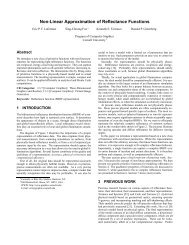pigmented colorants: dependence on media and time - Cornell ...
pigmented colorants: dependence on media and time - Cornell ...
pigmented colorants: dependence on media and time - Cornell ...
Create successful ePaper yourself
Turn your PDF publications into a flip-book with our unique Google optimized e-Paper software.
the most widely used pigment (many of the pigments <strong>on</strong> this list are derivatives of<br />
similar minerals).<br />
Gold ochre. Similar to yellow oxide, Gold Ochre derives its color from ir<strong>on</strong><br />
hydroxides. The c<strong>on</strong>tent of ir<strong>on</strong> oxide must not be less than 12% to be c<strong>on</strong>sidered<br />
an ochre. Depending up<strong>on</strong> the c<strong>on</strong>tent of hydrated ir<strong>on</strong> oxide, the color of ochre<br />
varies from light yellow to golden. While ochres occur all over the world, Mayer<br />
states that the best are mined <strong>and</strong> refined in France [May81]. It is <strong>on</strong>e of the oldest<br />
traditi<strong>on</strong>al artists’ pigments, is typically very opaque <strong>and</strong> dries to an excellent film.<br />
Raw umber. Umber (literally shade) is <strong>on</strong>e of the most widely used browns. It is<br />
a variety of ochre obtaining its color from the presence of ir<strong>on</strong> hydroxides (45-70%)<br />
<strong>and</strong> manganese oxide (5-20%). Historically, the pigment was mined near Umbria,<br />
Italy, but now the best umbers are mined primarily in Cyprus. The pigment has<br />
a high opacity <strong>and</strong> tinting strength. Due to its manganese c<strong>on</strong>tent, umber hastens<br />
the drying of <strong>media</strong>, but forms a good, flexible film.<br />
Burnt sienna. The pigment sienna owes its name to the Tuscan hills surround-<br />
ing Siena, Italy. Raw sienna is hydrated ir<strong>on</strong> oxide closely resembling yellow ochre<br />
(40-70% hydrated ir<strong>on</strong> oxide c<strong>on</strong>tent). When a lim<strong>on</strong>ite, like sienna, is calcined<br />
(or roasted) at high temperatures, its water c<strong>on</strong>tent is eliminated <strong>and</strong> it becomes<br />
a hematite (anhydrous), or burnt sienna. This process changes the pigment to<br />
have excepti<strong>on</strong>al translucency (different from most other earths) <strong>and</strong> a deep rich<br />
hue. Burnt sienna is <strong>on</strong>e of the most useful <strong>and</strong> versatile pigments: its masst<strong>on</strong>e<br />
a reddish brown, its glaze a fiery red, its tint with white a salm<strong>on</strong> pink. This<br />
pigment is highly absorbent of binding <strong>media</strong>.<br />
Red ochre. Natural red ochre has a greater percentage of ir<strong>on</strong> oxide than does<br />
147<br />
its yellow counterparts, to which yields its characteristic red color. French ochre,



